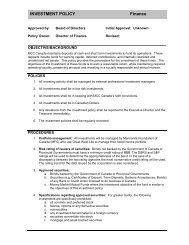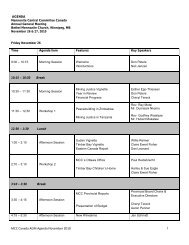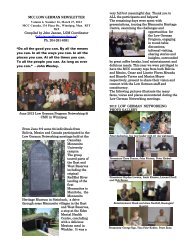Walking together: Healing and hope for Colombian refugees
Walking together: Healing and hope for Colombian refugees
Walking together: Healing and hope for Colombian refugees
You also want an ePaper? Increase the reach of your titles
YUMPU automatically turns print PDFs into web optimized ePapers that Google loves.
w a l k i n g<br />
t o g e t h e r<br />
105<br />
APPENDIX #2<br />
GUIDELINES FOR WORKING WITH INTERPRETERS<br />
BEFORE<br />
SESSION<br />
DURING<br />
SESSION<br />
DO<br />
Develop a pool of accessible, trained professional<br />
interpreters.<br />
Screen interpreters: determine their level of language<br />
sophistication, knowledge of the culture, sensitivity to<br />
mental health issues (especially confidentiality), <strong>and</strong><br />
general disposition <strong>for</strong> the tasks to be done. For mental<br />
health service delivery, it is important to ask about the<br />
interpreter’s own mental health. Many interpreters have<br />
their own trauma history <strong>and</strong> need to make in<strong>for</strong>med<br />
choices about re-exposure to traumatic events.<br />
Orient interpreters to your organization/church/<br />
committee’s mission, goals, structure, terminology <strong>and</strong><br />
roles. This should be ongoing rather than a one time<br />
ef<strong>for</strong>t.<br />
Develop <strong>and</strong> maintain good working relationships with<br />
interpreters.<br />
Expect tasks to take longer when an interpreter is used.<br />
Expect the interpreter to assist with clarification.<br />
Expect the interpreter to take notes when issues<br />
become complicated<br />
Prepare to repeat yourself in different words.<br />
Have the parties speak directly to each other, not to the<br />
interpreter. Make sure the interpreter speaks to both<br />
parties in the first person.<br />
Look at the client while you are speaking to her or him,<br />
not at the interpreter. Maintain gentle eye contact when<br />
the client or the interpreter speaks.<br />
Explain your role <strong>and</strong> that of the interpreter. It is<br />
especially important to address the issue of interpreter<br />
confidentiality <strong>and</strong> how the interpreter <strong>and</strong> client will<br />
h<strong>and</strong>le future interactions within the community.<br />
Use the interpreter as a cultural broker to avoid<br />
unnecessary misunderst<strong>and</strong>ing.<br />
DON’T<br />
Omit this stage. It is essential <strong>for</strong><br />
providing culturally competent<br />
services.<br />
Use a word-<strong>for</strong>-word interpreting<br />
<strong>for</strong>mat. Literal translation rarely makes<br />
it possible to re-express the original<br />
meaning due to uniqueness of each<br />
language.<br />
Chain questions (e.g. “Do you<br />
smoke or drink coffee?”)<br />
Say anything you don’t want<br />
the other party to hear.<br />
Talk about clients in their presence.<br />
If you need to consult with the<br />
interpreter, explain what you are<br />
doing to the client.<br />
Confuse the interpreter by backing<br />
up, rephrasing, or hesitating. Don’t<br />
“think aloud” or use a reflective style<br />
that changes, me<strong>and</strong>ers, or backs<br />
up in the middle, or erases parts.<br />
Talk fast.<br />
Guidelines <strong>for</strong> Working with Interpreters chart courtesy of the Center <strong>for</strong> Victims of Torture, 649 Dayton Ave., St. Paul, MN 55104,<br />
www.cvt.org ©Center <strong>for</strong> Victims of Torture











